Explainable Deep Learning to Predict Kelp Geographical Origin from Volatile Organic Compound Analysis
Abstract
1. Introduction
2. Materials and Methods
2.1. Sampling
2.2. Sample Preparation and GC–IMS Analysis
2.3. Modeling Procedure
2.4. One-Dimensional Convolutional Neural Network (1D-CNN)
2.5. Shapley Additive Explanations (SHAP)
2.6. Computing Implementation
3. Results and Discussion
3.1. Identification of VOCs in Kelp by GC-IMS
3.2. Model Performance of 1D-CNN
3.3. Interpretation of 1D-CNN Model with SHAP Values
3.3.1. Global Feature Interpretation
3.3.2. Local Feature Interpretation
4. Conclusions
Author Contributions
Funding
Institutional Review Board Statement
Informed Consent Statement
Data Availability Statement
Conflicts of Interest
References
- Salido, M.; Soto, M.; Seoane, S. Seaweed: Nutritional and gastronomic perspective. A review. Algal Res. 2023, 77, 103357. [Google Scholar]
- Gómez-Ordóñez, E.; Jiménez-Escrig, A.; Rupérez, P. Dietary fiber and physicochemical properties of several edible seaweeds from the northwestern Spanish coast. Food Res. Int. 2010, 43, 2289–2294. [Google Scholar] [CrossRef]
- Syad, A.N.; Shunmugiah, K.P.; Kasi, P.D. Seaweeds as nutritional supplements: Analysis of nutritional profile, physicochemical properties and proximate composition of G. acerosa and S. wightii. Biomed. Prev. Nutr. 2013, 3, 139–144. [Google Scholar] [CrossRef]
- Fernández-Segovia, I.; Lerma-Garcia, M.J.; Fuentes, A.; Barat, J.M. Characterization of Spanish powered seaweeds: Composition, antioxidant capacity and technological properties. Food Res. Int. 2018, 111, 212–219. [Google Scholar] [CrossRef]
- Wang, Y.X.; Guo, Y.Y.; Li, N.; Wang, L.Z.; Xu, J.C. Effects of processing methods on the nutritional quality of kelp. J. Food Saf. Qual. 2020, 11, 8229–8234. (In Chinese) [Google Scholar]
- Matos, J.; Cardoso, C.; Serralheiro, M.L.; Bandarra, N.M.; Afonso, C. Seaweed bioactives potential as nutraceuticals and functional ingredients: A review. J. Food Compos. Anal. 2024, 133, 106453. [Google Scholar]
- Aakre, I.; Solli, D.D.; Markhus, M.W.; Mæhre, H.K.; Dahlm, L.; Henjum, S.; Alexander, J.; Korneliussen, P.A.; Madsen, L.; Kjellevold, M. Commercially available kelp and seaweed products-valuable iodine source or risk of excess intake? Food Nutr. Res. 2021, 65, 7584. [Google Scholar] [CrossRef]
- Banach, J.L.; Koch, S.J.I.; Hoffmans, Y.; van den Burg, S.W.K. Seaweed value chain stakeholder perspectives for food and environmental safety hazards. Foods 2022, 11, 1514. [Google Scholar] [CrossRef]
- Prashant, N.; Sangwan, M.; Singh, P.; Das, P.; Srivastava, U.; Bast, F. Ati-nutritional factors and heavy metals in edible seaweeds: Challenges, health implications, and strategies for safer consumption. J. Food Compos. Anal. 2025, 140, 107283. [Google Scholar]
- Lin, H.; Zhou, Q.; Mu, Q.G.; Fu, X.T. Quality safety issues and countermeasures of Chinese seaweed food. J. Food Sci. Technol. 2015, 33, 8–11. [Google Scholar]
- Nie, J.L.; Fu, X.T.; Wang, L.; Xu, J.C.; Gao, X. Impact of Monascus purpureus fermentation on antioxidant activity, free amino acid profiles and flavor properties of kelp (Saccharina japonica). Food Chem. 2023, 400, 133990. [Google Scholar] [CrossRef] [PubMed]
- Duarte, B.; Mamede, R.; Caçador, I.; Melo, R.; Fonseca, V.F. Trust your seaweeds: Fine-scale multi-elemental traceability of edible seaweed species harvested within an estuarine system. Algal Res. 2023, 70, 102975. [Google Scholar] [CrossRef]
- Toyoda, K.; Wu, H.; Aktar, Z. Europium anomaly as a robust geogenic fingerprint for the geographical origin of aquatic products: A case study of nori (Neopyropia yezoensis) from the Japanese market. Food Chem. 2025, 464, 141719. [Google Scholar] [CrossRef] [PubMed]
- Yang, Y.; Yang, L.C.; He, S.Y.; Cao, X.Q.; Huang, J.M.; Ji, X.L.; Tong, H.B.; Zhang, X.; Wu, M.J. Use of near-infrared spectroscopy and chemometrics for fast discrimination of Sargassum fusiforme. J. Food Compos. Anal. 2022, 110, 104537. [Google Scholar] [CrossRef]
- Suzuki, Y.; Kokubun, A.; Edura, T.; Nakayama, K. Tracing the Geographical Origin of Blanched and Salted Wakame (Undaria Pinnatifida) from Japan (Naruto and Sanriku), China, and South Korea, Based on Stable Carbon, Nitrogen, and Oxygen Isotopic Composition. Nippon Shokuhin Kagaku Kogaku Kaishi 2013, 60, 1–10. (In Japanese) [Google Scholar] [CrossRef][Green Version]
- Yao, L.Y.; Liang, Y.; Sun, M.; Song, S.Q.; Wang, H.T.; Dong, Z.B.; Feng, T.; Yue, H. Characteristic volatile fingerprints of three edible marine green algae (Ulva spp.) in China by HS-GC-IMS and evaluation of the antioxidant bioactivities. Food Res. Int. 2024, 162, 112109. [Google Scholar] [CrossRef]
- Zhao, Z.Y.; Lian, F.Y.; Jiang, Y.J. Recognition of rice species based on gas chromatography-ion mobility spectrometry and deep learning. Agriculture 2024, 14, 1552. [Google Scholar] [CrossRef]
- Feng, Y.H.; Wang, Y.; Beykal, B.; Qiao, M.Y.; Xiao, Z.L.; Luo, Y.C. A mechanistic review on machine learning-supported detection and analysis of volatile organic compounds for food quality and safety. Trends Food Sci. Technol. 2024, 143, 104297. [Google Scholar] [CrossRef]
- Tseng, Y.J.; Chuang, P.J.; Appell, M. When machine learning and deep learning come to the big data in food chemistry. ACS Omega 2023, 8, 15854–15864. [Google Scholar] [CrossRef]
- Deng, Z.W.; Wang, T.; Zheng, Y.; Zhang, W.L.; Yun, Y.H. Deep learning in food authenticity: Recent advances and future trends. Trends Food Sci. Technol. 2024, 144, 104344. [Google Scholar] [CrossRef]
- Kiranyaz, S.; Avci, O.; Abdeljaber, O.; Ince, T.; Gabbouj, M.; Inman, D.J. 1D convolutional neural networks and applications: A survey. Mech. Syst. Signal Process. 2021, 151, 107398. [Google Scholar]
- Sun, Y.; Liu, N.; Zhao, L.; Liu, Q.; Wang, S.S.; Sun, G.H.; Zhao, Y.F.; Zhou, D.Q.; Cao, R. Attenuated total reflectance-flourier transformed infrared spectroscopy (ATR-FTIR) coupled with deep learning: A rapid method for geographical origin identification of sea cucumber Apostichopus japonicas. Microchem. J. 2024, 204, 111037. [Google Scholar]
- Jiang, X.N.; Liu, Q.C.; Yan, L.; Cao, X.D.; Chen, Y.; Wei, Y.Q.; Wang, F.; Xiong, H. Hyperspectral imaging combined with spectral-imagery feature fusion convolutional neural network to discriminate different geographical origins of wolfberries. J. Food Compos. Anal. 2024, 132, 106259. [Google Scholar]
- Zhao, X.; Liu, X.; Xie, P.X.; Ma, J.Y.; Shi, Y.N.; Jiang, H.Z.; Zhao, Z.L.; Wang, X.Y.; Li, C.H.; Yang, J. Identification of geographical origin of semen ziziphi spinosae based on hyperspectral imaging combined with convolutional neural networks. Infrared Phys. Technol. 2024, 136, 104982. [Google Scholar] [CrossRef]
- Chu, Y.H.; Wu, J.J.; Yan, Z.; Zhao, Z.Z.; Xu, D.M.; Wu, H. Towards generalizable food source identification: An explainable deep learning approach to rice authentication employing stable isotope and elemental marker analysis. Food Res. Int. 2024, 179, 113967. [Google Scholar] [CrossRef]
- Lundberg, S.M.; Lee, S.L. A unified approach to interpreting model predictions. In Proceedings of the 31st Conference on Neural Information Processing Systems NIPS, Long Beach, CA, USA; 2017. [Google Scholar]
- Tan, A.D.; Zhou, F.T.; Chen, H. Post-hoc part-prototype networks. In Proceedings of the 41st International Conference on Machine Learning, Vienna, Austria; 2024; Volume 235. [Google Scholar]
- Kang, X.M.; Zhao, Y.F.; Yao, L.; Tan, Z.J. Explainable machine learning for predicting the geographical origin of Chinese Oysters via mineral elements analysis. Curr. Res. Food Sci. 2024, 8, 100738. [Google Scholar]
- Ministry of Agriculture of China (MOAC). China Fisheries Yearbook; China Agriculture Publisher: Beijing, China, 2024. [Google Scholar]
- Wei, S.B.; Wu, Q.; Wang, Z.M.; Yu, X.L.; Jiao, J.; Dong, X.P. Determination of key volatile fishy substances of sea cucumber powder during the processing and their removal by supercritical fluid extraction. Food Res. Int. 2024, 190, 114603. [Google Scholar] [CrossRef]
- Li, W.Q.; Chen, Y.P.; Blank, I.; Li, F.Y.; Li, C.B.; Liu, Y. GC × GC-ToF-MS and GC-IMS based volatile profile characterization of the Chinese dry cured hams from different regions. Food Res. Int. 2021, 142, 110222. [Google Scholar]
- Yao, L.Y.; Sun, J.Y.; Liang, Y.; Feng, T.; Wang, H.T.; Sun, M.; Yu, W.G. Volatile fingerprints of Torreya grandis hydrosols under different downstream processes using HS-GC–IMS and the enhanced stability and bioactivity of hydrosols by high pressure homogenization. Food Control 2022, 139, 109058. [Google Scholar]
- Kapoor, S.; Narayanan, A. Leakage and the reproducibility crisis in machine learning-based science. Patterns 2023, 4, 100804. [Google Scholar] [CrossRef]
- Singh, D.; Singh, B. Feature wise normalization: An effective way of normalizing data. Pattern Recognit. 2022, 122, 108307. [Google Scholar]
- Li, Z.K.; Lan, Y.F.; Lin, W.W. Footbridge damage detection using smartphone-recorded responses of micromobility and convolutional neural networks. Autom. Constr. 2024, 166, 105587. [Google Scholar] [CrossRef]
- Lauritsen, S.M.; Kristensen, M.; Olsen, M.V.; Larsen, M.S.; Lauritsen, K.M.; Jørgensen, M.J.; Lange, J.; Thiesson, B. Explainable artificial intelligence model to predict acute critical illness from electronic health records. Nat. Commun. 2020, 11, 3852. [Google Scholar] [PubMed]
- Pradhan, B.; Lee, S.; Dikshit, A.; Kim, H. Spatial flood susceptibility mapping using an explainable artificial intelligence (XAI) model. Geosci. Front. 2023, 14, 101625. [Google Scholar]
- Lundberg, S.M.; Nair, B.; Vavilala, M.S.; Horibe, M.; Eisses, M.J.; Adams, T.; Liston, D.E.; Low, D.K.W.; Newman, S.F.; Kim, J.; et al. Explainable machine-learning predictions for the prevention of hypoxaemia during surgery. Nat. Biomed. Eng. 2018, 2, 749–760. [Google Scholar]
- Wei, R.; Jiang, B.; Chen, J.J.; Xiang, L.B.; Liu, X.Y. Removal of fishy flavor in kelp (Laminaria japonica) by natural antioxidant soaking combined with microbial fermentation. Food Biosci. 2024, 60, 104212. [Google Scholar]
- Jiang, H.J.; Dai, A.N.; Yan, L.Q.; Zhang, Z.C.; Ding, B.; Bai, J.L.; Yang, J.T.; Gao, D.D.; Liu, H.N. Analysis of volatile organic compounds (VOCs) in yak ghee from different pastoral areas of China based on GC-IMS. Int. Dairy J. 2025, 160, 106098. [Google Scholar]
- Jiang, S.; Jiang, P.F.; Feng, D.D.; Jin, M.R.; Qi, H. Characterization of flavor substances in cooking and seasoned cooking brown seaweeds by GC-IMS and E-nose. Food Chem. X 2024, 22, 101325. [Google Scholar]
- Zhu, W.Y.; Jiang, B.; Zhong, F.; Chen, J.J.; Zhang, T. Effect of microbial fermentation on the fishy-odor compounds in kelp (Laminaria japonica). Foods 2021, 10, 2532. [Google Scholar] [CrossRef]
- Li, S.; Hu, M.J.; Tong, Y.P.; Xia, Z.Y.; Tong, Y.C.; Sun, Y.Q.; Cao, J.X.; Zhang, J.H.; Liu, J.L.; Zhao, S.; et al. A review of volatile compounds in edible macroalgae. Food Res. Int. 2023, 165, 112559. [Google Scholar]
- Seo, Y.S.; Bae, H.N.; Eom, S.H.; Lim, K.S.; Yun, I.H.; Chuang, Y.H.; Jeon, J.M.; Kim, H.W.; Lee, M.S.; Lee, Y.B.; et al. Removal of off-flavors from sea tangle (Laminaria japonica) extract by fermentation with Aspergillus oryzae. Bioresour. Technol. 2012, 121, 475–479. [Google Scholar] [CrossRef] [PubMed]
- Srianta, I.; Ristiarini, S.; Nugerahani, I.; Sen, S.K.; Zhang, B.B.; Xu, G.R.; Blanc, P.J. Recent research and development of Monascus fermentation products. Int. Food Res. J. 2014, 21, 1–12. [Google Scholar]
- Wang, C.M.; Yu, J.W.; Gallagher, D.L.; Byrd, J.; Yao, W.C.; Wang, Q.; Guo, Q.Y.; Dietrich, A.M.; Yang, M. Pyrazines: A diverse class of earthy-musty odorants impacting drinking water quality and consumer satisfaction. Water Res. 2020, 182, 115971. [Google Scholar] [CrossRef]
- Mirzayeva, A.; Castro, R.; Barroso, C.G.; Durán-Guerrero, E. Characterization and differentiation of seaweeds on the basis of their volatile composition. Food Chem. 2021, 336, 127725. [Google Scholar] [CrossRef]
- Zhang, H.W.; Li, Y.J.; Cao, W.; Li, J.W.; Zhou, X.J.; Qiu, Z.M.; Chen, T.T.; Xu, Y.J.; Sun, L.Q.; Cui, Y.M. Study on the origin traceability of Laminaria japonica based on fatty acid fingerprints. Lab. Test. 2023, 1, 11–20. (In Chinese) [Google Scholar]
- Ekanayake, I.U.; Meddage, D.P.P.; Rathnayake, U. A novel approach to explain the black-box nature of machine learning in compressive strength predictions of concrete using Shapley additive explanations (SHAP). Case Stud. Constr. Mater. 2022, 16, e01059. [Google Scholar] [CrossRef]
- Lundberg, S.M.; Erion, G.; Chen, H.; Degrave, A.; Prutkin, J.M.; Nair, B.; Katz, R.; Himmelfarb, J.; Bansal, N.; Lee, S.I. From local explanations to global understanding with explainable AI for trees. Nat. Mach. Intell. 2020, 2, 56–67. [Google Scholar] [CrossRef]
- Huang, J.X.; Li, Z.; Zhang, W.; Lv, Z.Y.; Dong, S.Y.; Feng, Y.; Liu, R.X.; Zhao, Y. Explainable machine learning-assisted origin identification: Chemical profiling of five lotus (Nelumbo nucifera Gaertn.) parts. Food Chem. 2023, 404, 134517. [Google Scholar] [CrossRef]
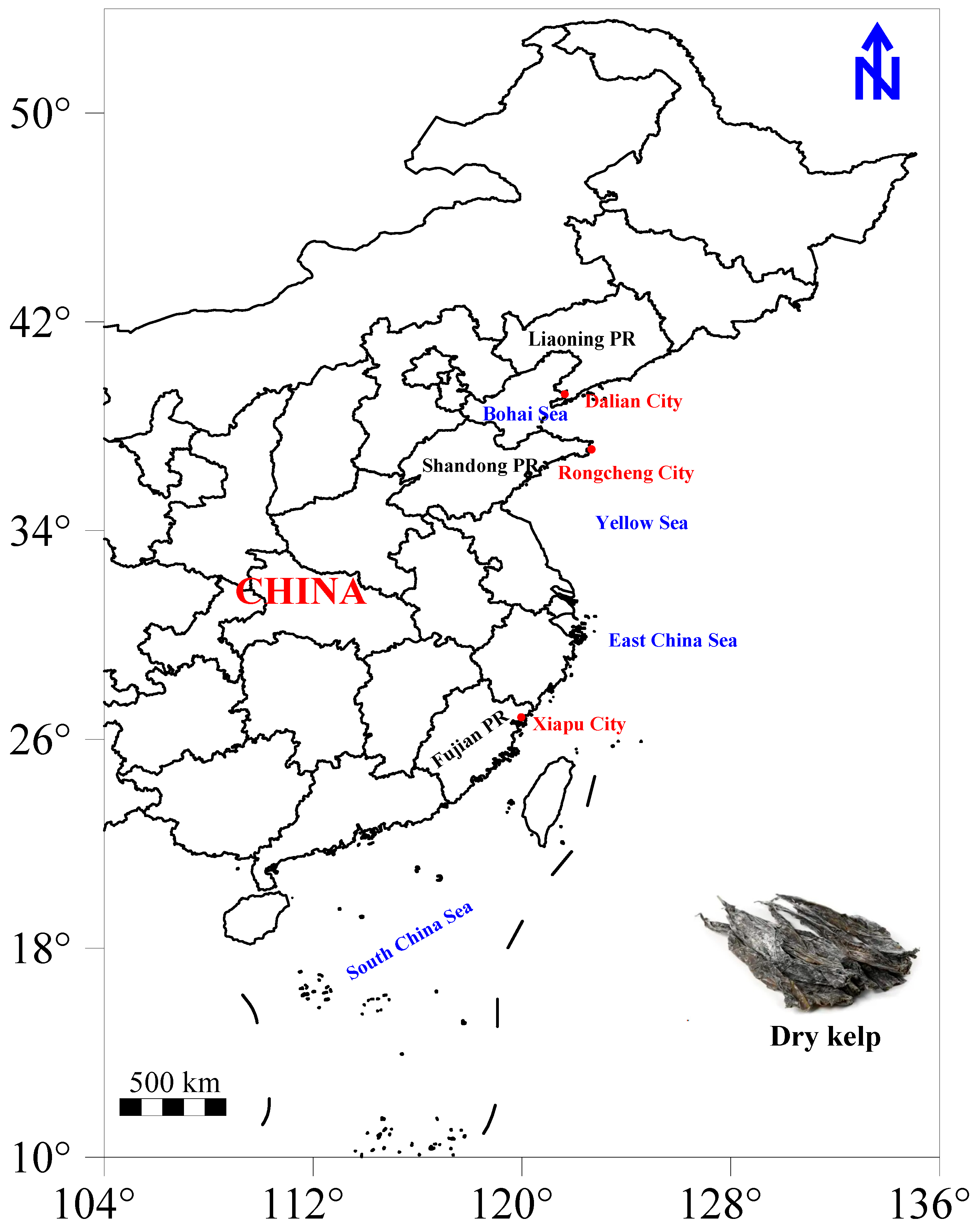

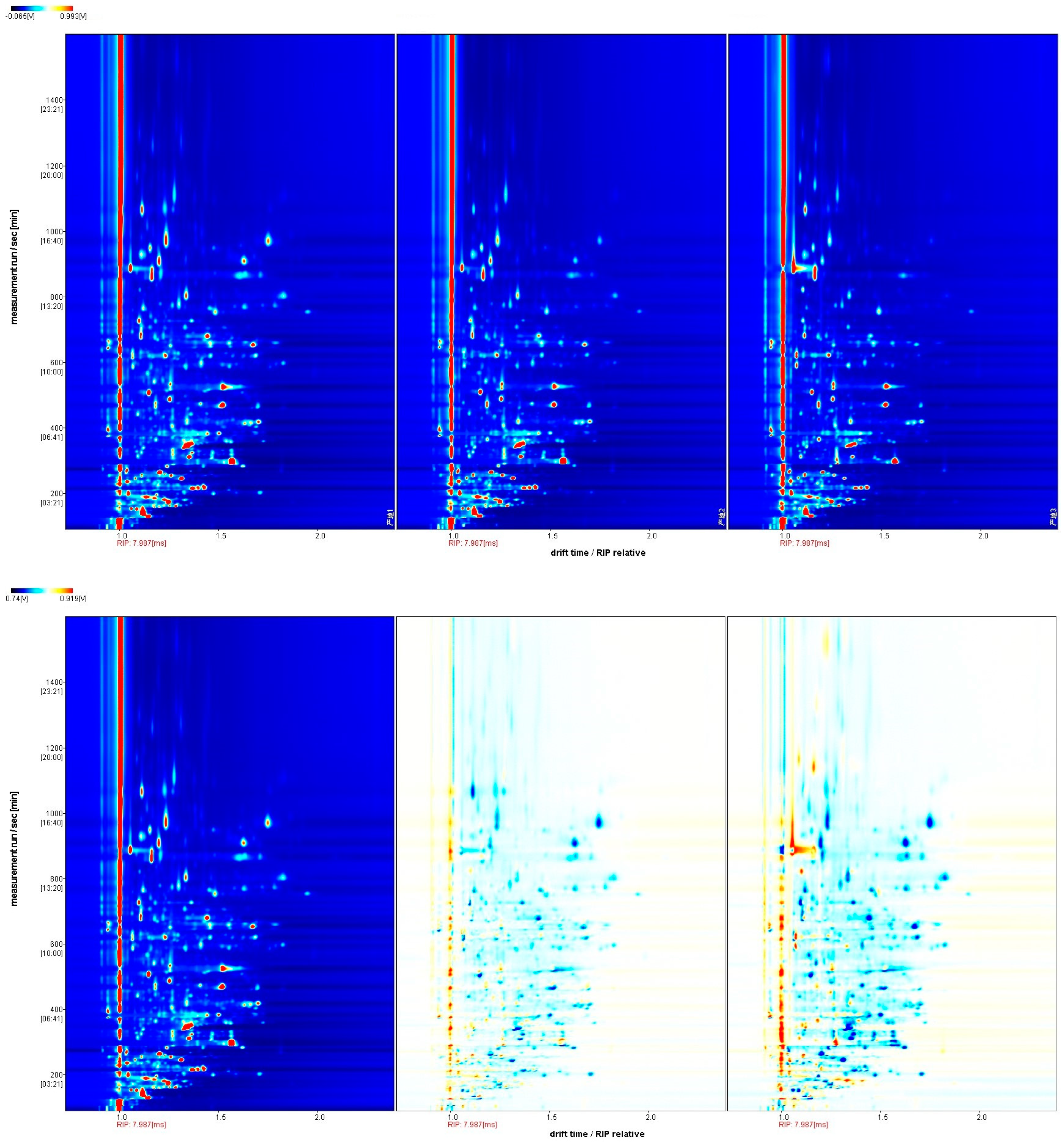
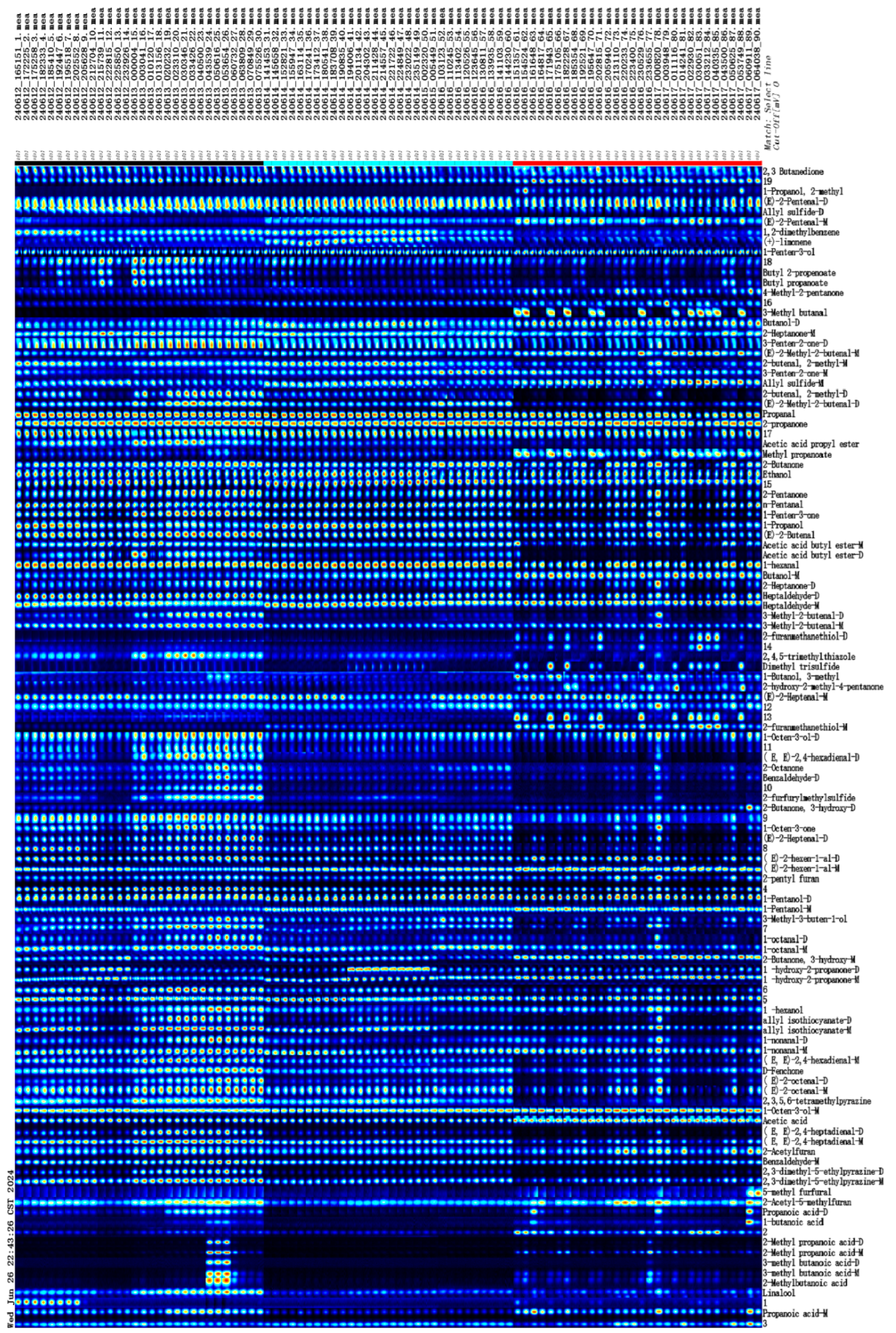
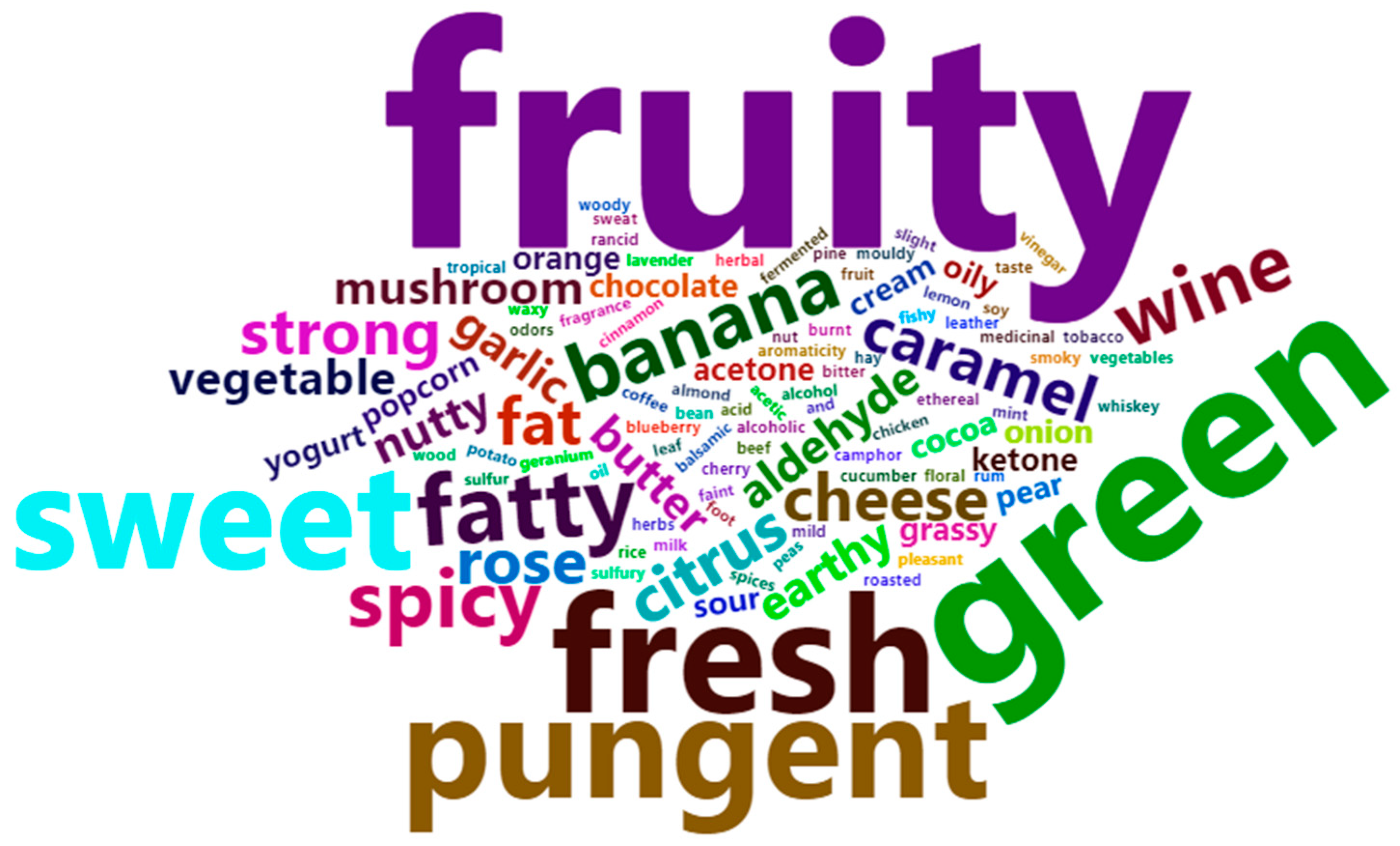

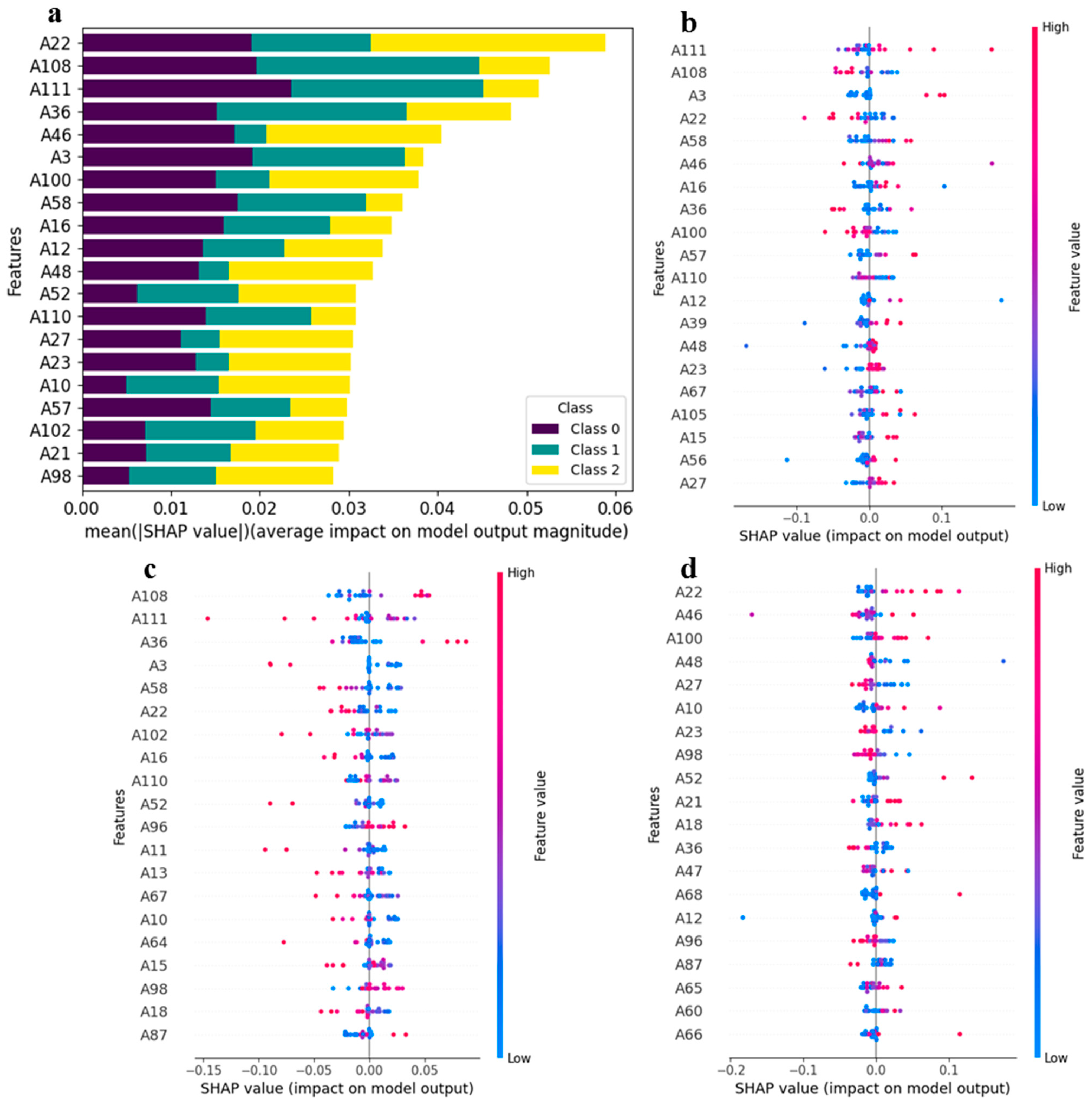
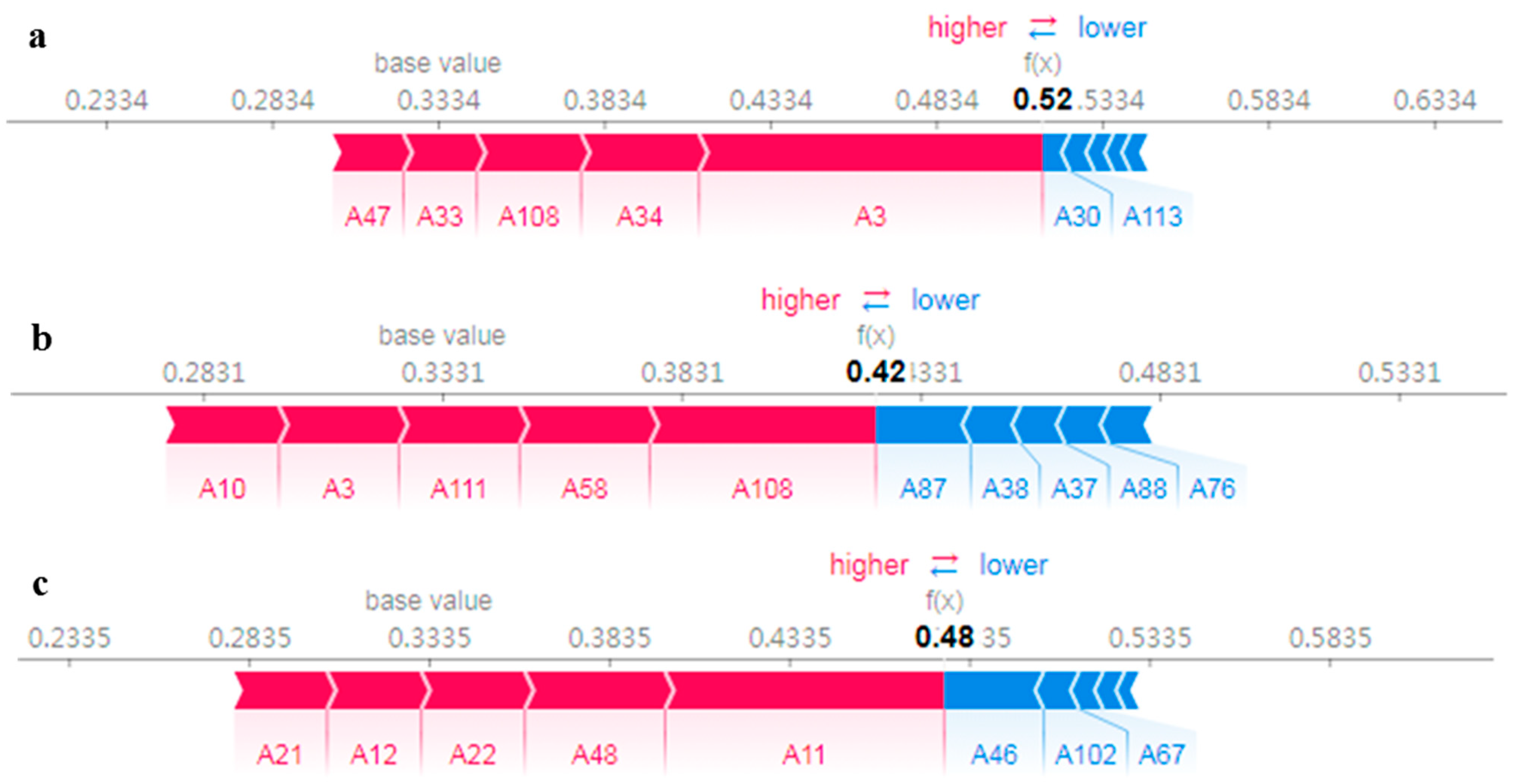
| Features | Compound | RI | Rt [sec] | Dt [a.u.] | Signal Intensities | p Value | Odor Description | ||
|---|---|---|---|---|---|---|---|---|---|
| Rongcheng | Dalian | Xiapu | |||||||
| Acids | |||||||||
| A6 | 3-Methyl butanoic acid-M | 1704.9 | 1517.861 | 1.23403 | 1755.2 ± 3254.1 a | 707.6 ± 102.0 a | 1758.4 ± 936.9 a | 0.062 | sour, foot sweat, cheese |
| A7 | 3-Methyl butanoic acid-D | 1705.2 | 1519.095 | 1.49786 | 1254.2 ± 1993.5 a | 1088.8 ± 191.3 a | 1232.0 ± 210.2 a | 0.837 | |
| A5 | 2-Methylbutanoic acid | 1704.2 | 1515.632 | 1.20697 | 917.1 ± 1550.6 a | 470.9 ± 96.8 a | 880.5 ± 445.2 a | 0.127 | pungent and spicy cheese, fruity |
| A8 | 2-Methyl propanoic acid-M | 1578.1 | 1136.913 | 1.15979 | 1705.9 ± 2698.7 ab | 864.3 ± 177.4 b | 2534.7 ± 1173.2 a | 0.001 | yogurt, rancid cream |
| A9 | 2-Methyl propanoic acid-D | 1579 | 1139.117 | 1.38345 | 1026.4 ± 1904.3 a | 615.5 ± 110.0 a | 815.3 ± 369.7 a | 0.370 | |
| A21 | Acetic acid | 1470.1 | 888.662 | 1.05409 | 5158.9 ± 378.3 b | 4404.3 ± 402.2 c | 8421.3 ± 728.6 a | <0.001 | spicy |
| A2 | Propanoic acid-M | 1548.1 | 1061.727 | 1.1132 | 3851.4 ± 1081.0 a | 1395.8 ± 210.0 b | 3565.2 ± 1331.5 a | <0.001 | yogurt, vinegar |
| A12 | Propanoic acid-D | 1548.1 | 1061.727 | 1.27443 | 698.1 ± 401.3 a | 248.5 ± 36.8 b | 548.7 ± 465.0 a | <0.001 | |
| A11 | 1-Butanoic acid | 1647.1 | 1330.54 | 1.17401 | 442.5 ± 247.0 b | 390.6 ± 71.5 b | 739.5 ± 483.0 a | <0.001 | strong acetic acid, cheese, butter, fruity |
| Pyrazines | |||||||||
| A16 | 2,3-Dimethyl-5-ethylpyrazine-D | 1507.9 | 968.664 | 1.75452 | 3989.6 ± 1749.1 a | 1442.4 ± 280.9 b | 994.2 ± 421.7 b | <0.001 | burnt popcorn, roasted cocoa |
| A15 | 2,3-Dimethyl-5-ethylpyrazine-M | 1510.5 | 974.378 | 1.23681 | 5998.3 ± 825.3 a | 4251.7 ± 379.3 b | 3192.7 ± 922.7 c | <0.001 | |
| A23 | 2,3,5,6-Tetramethylpyrazine | 1460.7 | 869.986 | 1.2092 | 1148.4 ± 203.0 a | 1002.0 ± 167.5 b | 374.9 ± 122.7 c | <0.001 | beef, fermented soy |
| Aldehydes | |||||||||
| A19 | (E, E)-2,4-Heptadienal-M | 1480.8 | 910.703 | 1.20277 | 4181.0 ± 489.5 a | 3231.2 ± 228.4 b | 1916.9 ± 776.0 c | <0.001 | fatty, oily, aldehyde, vegetable, cinnamon |
| A20 | (E, E)-2,4-Heptadienal-D | 1480.4 | 909.887 | 1.63091 | 3028.0 ± 1261.9 a | 1200.4 ± 236.6 b | 674.4 ± 375.4 c | <0.001 | |
| A17 | Benzaldehyde-M | 1500.4 | 952.337 | 1.15978 | 1759.6 ± 206.0 a | 1555.0 ± 118.3 b | 1395.3 ± 236.2 c | <0.001 | bitter almond, cherry, nutty |
| A55 | Benzaldehyde-D | 1498.5 | 948.255 | 1.47865 | 503.9 ± 184.6 a | 306.3 ± 35.2 b | 276.6 ± 86.8 b | <0.001 | |
| A24 | (E)-2-Octenal-M | 1427.8 | 807.027 | 1.33713 | 2655.6 ± 374.3 a | 2123.9 ± 236.8 b | 1372.5 ± 726.6 c | <0.001 | fresh cucumber, fatty, green herbal, banana, green leaf |
| A25 | (E)-2-Octenal-D | 1427.4 | 806.211 | 1.82976 | 1602.5 ± 668.1 a | 845.8 ± 247.3 b | 526.1 ± 459.1 c | <0.001 | |
| A28 | 1-Nonanal-M | 1397 | 752.332 | 1.48402 | 1931.3 ± 237.0 a | 1701.6 ± 271.8 b | 1782.3 ± 424.6 ab | 0.023 | rose, citrus, strong oily |
| A29 | 1-Nonanal-D | 1398.9 | 755.597 | 1.95516 | 741.1 ± 298.0 a | 454.5 ± 114.7 b | 463.1 ± 242.6 b | <0.001 | |
| A14 | 5-Methyl furfural | 1557.9 | 1085.791 | 1.13658 | 206.6 ± 54.4 b | 170.7 ± 26.8 b | 306.7 ± 177.0 a | <0.001 | spices, caramel wood |
| A27 | (E, E)-2,4-Hexadienal-M | 1405.7 | 767.443 | 1.12077 | 1291.0 ± 218.0 a | 902.4 ± 115.6 b | 498.5 ± 199.8 c | <0.001 | sweet, green, floral, citrus |
| A57 | (E, E)-2,4-Hexadienal-D | 1406.5 | 768.733 | 1.45577 | 595.3 ± 302.4 a | 216.9 ± 61.0 b | 113.6 ± 70.8 c | <0.001 | |
| A63 | (E)-2-Heptenal-M | 1336.2 | 654.959 | 1.25583 | 744.0 ± 124.3 a | 768.4 ± 140.0 a | 720.2 ± 177.3 a | 0.458 | spicy, green vegetables, fresh, fatty |
| A49 | (E)-2-Heptenal-D | 1336.2 | 654.959 | 1.67623 | 3101.0 ± 865.8 a | 1952.0 ± 390.4 b | 1001.2 ± 761.1 c | <0.001 | |
| A72 | Heptaldehyde-M | 1191.2 | 419.599 | 1.34079 | 1518.4 ± 210.9 b | 1708.4 ± 137.0 a | 1559.6 ± 153.1 b | <0.001 | fresh, aldehyde, fatty, green herbs, wine, fruity |
| A73 | Heptaldehyde-D | 1191.2 | 419.599 | 1.70179 | 2101.4 ± 269.1 a | 1725.6 ± 187.8 b | 1276.9 ± 539.7 c | <0.001 | |
| A76 | 1-Hexanal | 1094.8 | 297.552 | 1.56891 | 9942.1 ± 532.5 a | 10087.0 ± 215.3 a | 6551.3 ± 2462.1 b | <0.001 | fresh, green, fat, fruity |
| A82 | n-Pentanal | 994.8 | 219.957 | 1.42916 | 3180.9 ± 171.2 a | 3016.9 ± 121.4 a | 2361.7 ± 528.9 b | <0.001 | green grassy, faint banana, pungent |
| A101 | 3-Methyl butanal | 925.3 | 183.139 | 1.4087 | 63.9 ± 24.0 b | 71.6 ± 12.0 b | 1043.7 ± 991.7 a | <0.001 | chocolate, fat |
| A97 | (E)-2-Methyl-2-butenal-M | 1108.9 | 312.596 | 1.09283 | 581.3 ± 103.0 c | 678.0 ± 59.0 b | 919.1 ± 177.0 a | <0.001 | |
| A92 | (E)-2-Methyl-2-butenal-D | 1107.8 | 311.409 | 1.34962 | 3436.3 ± 1152.5 a | 2576.4 ± 718.5 b | 1381.0 ± 511.7 c | <0.001 | |
| A110 | (E)-2-Pentenal-M | 1143.2 | 353.373 | 1.1042 | 243.0 ± 58.7 c | 433.2 ± 57.0 b | 575.4 ± 151.6 a | <0.001 | potato, peas |
| A112 | (E)-2-Pentenal-D | 1142.2 | 352.186 | 1.36666 | 2885.9 ± 284.6 a | 2944.2 ± 215.2 a | 2250.4 ± 557.5 b | <0.001 | |
| A46 | (E)-2-Hexen-1-al-M | 1224.9 | 470.305 | 1.18185 | 2112.4 ± 282.8 c | 2444.0 ± 112.4 b | 2813.3 ± 334.5 a | <0.001 | green, banana, fat |
| A47 | (E)-2-Hexen-1-al-D | 1226.6 | 473.163 | 1.52571 | 5560.2 ± 1109.4 a | 3992.7 ± 766.5 b | 4026.1 ± 1971.6 b | <0.001 | |
| A70 | 3-Methyl-2-butenal-M | 1207.6 | 443.624 | 1.09281 | 688.1 ± 123.6 a | 536.8 ± 61.3 c | 604.1 ± 124.9 b | <0.001 | fruity |
| A71 | 3-Methyl-2-butenal-D | 1208.5 | 445.053 | 1.36405 | 628.5 ± 303.6 a | 250.7 ± 53.7 b | 253.5 ± 204.1 b | <0.001 | |
| A91 | Propanal | 800.4 | 131.726 | 1.1456 | 5194.1 ± 136.1 a | 5008.8 ± 217.8 a | 4134.7 ± 801.0 b | <0.001 | pungent, green grassy |
| A79 | (E)-2-Butenal | 1057.6 | 265.853 | 1.20228 | 4939.1 ± 931.4 a | 3604.7 ± 280.9 b | 2657.7 ± 818.8 c | <0.001 | |
| A38 | 1-Octanal-M | 1295.2 | 596.509 | 1.40975 | 1473.4 ± 229.0 a | 1288.3 ± 199.1 b | 899.4 ± 278.4 c | <0.001 | aldehyde, waxy, citrus, orange, fruity, fatty |
| A39 | 1-Octanal-D | 1297.6 | 599.763 | 1.82402 | 697.4 ± 316.2 a | 384.0 ± 118.7 b | 289.6 ± 167.4 b | <0.001 | |
| A93 | 2-Butenal, 2-methyl-D | 1120.2 | 325.542 | 1.3698 | 1038.4 ± 475.9 a | 611.4 ± 132.7 b | 184.7 ± 163.3 c | <0.001 | |
| A96 | 2-Butenal, 2-methyl-M | 1122.3 | 327.897 | 1.11449 | 463.3 ± 100.0 a | 514.6 ± 112.2 a | 275.9 ± 94.9 b | <0.001 | |
| Alcohols | |||||||||
| A22 | 1-Octen-3-ol-M | 1457 | 862.538 | 1.16157 | 4006.9 ± 129.7 b | 4000.7 ± 264.4 b | 4565.8 ± 390.3 a | <0.001 | mushroom, lavender, rose, hay |
| A59 | 1-Octen-3-ol-D | 1457 | 862.538 | 1.60583 | 1842.4 ± 383.1 a | 1265.9 ± 231.0 b | 1257.5 ± 474.7 b | <0.001 | |
| A4 | Linalool | 1549.8 | 1065.809 | 1.22785 | 1905.6 ± 582.5 a | 1153.8 ± 176.9 b | 1182.1 ± 286.8 b | <0.001 | citrus, rose, woody, blueberry |
| A80 | 1-Propanol | 1046.1 | 256.775 | 1.25872 | 1757.2 ± 330.5 a | 1844.2 ± 187.8 a | 1105.3 ± 409.1 b | <0.001 | alcohol, pungent |
| A107 | 1-Penten-3-ol | 1166.9 | 384.649 | 0.93944 | 2660.7 ± 253.7 c | 3093.6 ± 213.5 b | 3302.9 ± 204.0 a | <0.001 | ethereal, green, tropical fruity |
| A42 | 1-Pentanol-M | 1259 | 527.955 | 1.25583 | 2333.4 ± 400.3 c | 2918.4 ± 261.3 b | 3308.2 ± 547.3 a | <0.001 | balsamic |
| A43 | 1-Pentanol-D | 1258.3 | 526.526 | 1.5216 | 4883.0 ± 321.2 a | 4574.2 ± 552.3 ab | 4276.7 ± 860.1 b | 0.001 | |
| A85 | Ethanol | 940.9 | 190.799 | 1.13695 | 3377.6 ± 347.3 b | 3790.7 ± 595.2 a | 2907.5 ± 625.4 c | <0.001 | aromaticity |
| A113 | 1-Propanol, 2-methyl | 1102.8 | 305.806 | 1.17346 | 43.4 ± 6.17 b | 58.3 ± 17.1 b | 195.2 ± 114.6 a | <0.001 | fresh, alcoholic, leather |
| A75 | Butanol-M | 1153.4 | 366.495 | 1.18517 | 626.2 ± 103.7 c | 936.1 ± 132.4 b | 1324.6 ± 202.1 a | <0.001 | wine |
| A100 | Butanol-D | 1153 | 366.058 | 1.39075 | 431.5 ± 84.6 c | 584.5 ± 108.4 b | 690.2 ± 101.0 a | <0.001 | |
| A60 | 2-Furanmethanethiol-M | 1436.6 | 823.458 | 1.10216 | 340.1 ± 41.1 c | 583.2 ± 129.5 b | 1293.7 ± 510.0 a | <0.001 | sulfury, coffee, fat, smoky |
| A69 | 2-Furanmethanethiol-D | 1436.1 | 822.467 | 1.35824 | 111.4 ± 14.5 b | 126.0 ± 16.2 b | 346.4 ± 244.0 a | <0.001 | |
| A32 | 1-Hexanol | 1369.8 | 707.132 | 1.32947 | 613.9 ± 162.7 a | 466.2 ± 80.7 b | 548.7 ± 138.6 a | <0.001 | fresh, fruity, wine, sweet, green |
| A41 | 3-Methyl-3-buten-1-ol | 1267.3 | 542.825 | 1.17532 | 945.4 ± 190.5 a | 847.2 ± 198.1 a | 624.4 ± 212.7 b | <0.001 | sweet, fruity |
| A65 | 1-Butanol, 3-methyl | 1213.6 | 452.748 | 1.24885 | 379.4 ± 116.5 b | 373.0 ± 79.8 b | 606.4 ± 163.8 a | <0.001 | whiskey, banana, fruity |
| Ether | |||||||||
| A53 | 2-Furfurylmethylsulfide | 1529.9 | 1018.461 | 1.14007 | 669.3 ± 369.7 a | 374.0 ± 109.5 b | 256.2 ± 74.5 c | <0.001 | pungent, onion, garlic |
| A94 | Allyl sulfide-M | 1135.3 | 343.522 | 1.12292 | 534.2 ± 102.8 c | 657.0 ± 142.8 b | 727.3 ± 155.4 a | <0.001 | garlic |
| A111 | Allyl sulfide-D | 1136.9 | 345.475 | 1.32433 | 3624.2 ± 608.1 a | 2616.3 ± 410.0 b | 1835.6 ± 330.6 c | <0.001 | |
| Furan | |||||||||
| A18 | 2-Acetylfuran | 1489.8 | 929.479 | 1.1132 | 1897.4 ± 335.0 a | 1626.7 ± 113.4 b | 1778.7 ± 631.9 a | 0.047 | fatty, sweet, caramel, nutty, tobacco |
| A13 | 2-Acetyl-5-methylfuran | 1623.4 | 1260.667 | 1.16629 | 700.2 ± 146.5 a | 553.7 ± 76.2 b | 740.9 ± 200.1 a | <0.001 | nut |
| A45 | 2-Pentyl furan | 1235.8 | 488.056 | 1.254 | 2734.8 ± 552.9 a | 2467.0 ± 627.9 ab | 2174.8 ± 1138.2 b | 0.033 | bean, fruity, earthy, green, vegetable |
| Esters | |||||||||
| A30 | Allyl isothiocyanate-M | 1382.5 | 727.841 | 1.09708 | 2224.6 ± 509.5 a | 1789.8 ± 317.3 b | 1168.6 ± 388.0 c | <0.001 | sulfur, pungent, garlic |
| A31 | Allyl isothiocyanate-D | 1382 | 727.025 | 1.36758 | 802.9 ± 394.7 a | 353.6 ± 186.4 b | 201.9 ± 196.2 c | <0.001 | |
| A78 | Acetic acid butyl ester-M | 1080.8 | 285.259 | 1.23975 | 1187.5 ± 136.8 a | 1062.5 ± 112.8 b | 629.4 ± 347.9 c | <0.001 | fruity |
| A77 | Acetic acid butyl ester-D | 1080.2 | 284.688 | 1.62402 | 804.8 ± 349.3 a | 460.0 ± 148.3 b | 141.8 ± 111.0 c | <0.001 | |
| A104 | Butyl propanoate | 1148.6 | 360.367 | 1.7279 | 397.2 ± 249.3 a | 240.8 ± 71.5 b | 223.0 ± 143.2 b | <0.001 | earthy, sweet rose |
| A88 | Acetic acid propyl ester | 958.3 | 199.773 | 1.47595 | 623.0 ± 170.8 a | 351.2 ± 61.7 b | 182.8 ± 60.9 c | <0.001 | fruity, pear |
| A87 | Methyl propanoate | 922.7 | 181.873 | 1.32964 | 642.4 ± 165.9 b | 636.7 ± 55.9 b | 1541.0 ± 505.2 a | <0.001 | fruit, rum |
| A105 | Butyl 2-propenoate | 1180.4 | 403.735 | 1.69254 | 421.9 ± 236.4 a | 190.8 ± 53.8 b | 162.1 ± 94.7 b | <0.001 | pungent, fruity |
| Ketones | |||||||||
| A26 | D-Fenchone | 1410.5 | 775.827 | 1.29762 | 1482.5 ± 200.8 a | 1101.7 ± 159.2 b | 876.2 ± 228.1 c | <0.001 | |
| A35 | 1-Hydroxy-2-propanone-M | 1314.8 | 623.695 | 1.06882 | 2376.7 ± 500.7 b | 2584.8 ± 277.9 b | 3100.3 ± 547.8 a | <0.001 | pungent, caramel, fresh |
| A36 | 1-Hydroxy-2-propanone-D | 1315.2 | 624.321 | 1.23408 | 2912.7 ± 1080.5 b | 3798.6 ± 2480.9 a | 2493.5 ± 479.2 b | 0.007 | |
| A37 | 2-Butanone, 3-hydroxy-M | 1292.5 | 591.181 | 1.07027 | 1147.4 ± 267.3 b | 1091.4 ± 255.2 b | 1898.0 ± 402.0 a | <0.001 | butter, cream |
| A52 | 2-Butanone, 3-hydroxy-D | 1292.8 | 591.806 | 1.33411 | 867.2 ± 137.5 b | 693.9 ± 51.9 b | 1209.0 ± 612.9 a | <0.001 | |
| A74 | 2-Heptanone-D | 1187.5 | 414.183 | 1.63388 | 1386.2 ± 415.6 a | 1069.9 ± 337.6 b | 917.3 ± 553.1 b | <0.001 | pear, banana, fruity, slight medicinal fragrance |
| A99 | 2-Heptanone-M | 1187 | 413.41 | 1.26216 | 1115.5 ± 113.4 ab | 1176.8 ± 68.1 a | 1083.2 ± 203.7 b | 0.036 | |
| A81 | 1-Penten-3-one | 1034.7 | 248.066 | 1.31212 | 3760.1 ± 1135.9 a | 2606.2 ± 339.6 b | 1217.0 ± 861.9 c | <0.001 | strong pungent odors |
| A83 | 2-Pentanone | 989.3 | 216.79 | 1.3678 | 3361.5 ± 783.3 a | 2641.8 ± 589.5 b | 1946.6 ± 995.9 c | <0.001 | acetone, fresh, sweet fruity, wine |
| A95 | 3-Penten-2-one-M | 1135.9 | 344.268 | 1.07465 | 160.7 ± 54.4 b | 268.5 ± 47.8 a | 263.6 ± 39.5 a | <0.001 | fruity, turns into spicy during storage |
| A98 | 3-Penten-2-one-D | 1138.4 | 347.435 | 1.34621 | 5146.3 ± 484.6 a | 4336.9 ± 242.5 b | 2673.7 ± 890.8 c | <0.001 | |
| A90 | 2-Propanone | 831.1 | 142.855 | 1.11774 | 11380.0 ± 788.2 a | 11109.0 ± 518.0 a | 10040.0 ± 1425.8 b | <0.001 | acetone, fresh, sweet fruity, wine |
| A86 | 2-Butanone | 912.6 | 177.101 | 1.24839 | 5011.7 ± 897.3 a | 4299.3 ± 831.5 b | 3314.8 ± 1568.1 c | <0.001 | fruity, camphor |
| A50 | 1-Octen-3-one | 1313.6 | 621.99 | 1.68755 | 1028.1 ± 297.8 a | 676.2 ± 209.9 b | 381.8 ± 316.0 c | <0.001 | strong earthy, mushroom, vegetable, fishy, chicken |
| A56 | 2-Octanone | 1289.3 | 584.723 | 1.76483 | 257.4 ± 113.9 a | 165.5 ± 56.6 b | 139.2 ± 48.2 b | <0.001 | moldy, ketone, milk, cheese, mushroom |
| A64 | 2-Hydroxy-2-methyl-4-pentanone | 1369 | 705.786 | 1.13888 | 231.7 ± 31.4 b | 187.1 ± 26.1 b | 354.4 ± 155.3 a | <0.001 | mild, pleasant |
| A103 | 4-Methyl-2-pentanone | 1013.6 | 232.746 | 1.17473 | 501.6 ± 64.0 b | 535.1 ± 96.0 b | 781.5 ± 242.5 a | <0.001 | ketone |
| A115 | 2,3 Butanedione | 980.5 | 211.786 | 1.17268 | 325.6 ± 67.6 a | 367.8 ± 101.0 a | 338.2 ± 62.4 a | 0.110 | butter, popcorn, sweet taste, sour rice |
| Others | |||||||||
| A66 | Dimethyl trisulfide | 1376.2 | 717.487 | 1.30222 | 141.8 ± 48.4 b | 137.6 ± 65.4 b | 306.8 ± 250.8 a | <0.001 | fresh onion, mint, spicy |
| A67 | 2,4,5-Trimethylthiazole | 1389.7 | 739.957 | 1.15652 | 375.2 ± 137.0 a | 230.0 ± 36.8 b | 122.1 ± 31.0 c | <0.001 | cocoa, chocolate, caramel, nutty |
| A109 | 1,2-Dimethylbenzene | 1228.7 | 476.488 | 1.06399 | 252.5 ± 50.1 a | 279.8 ± 75.5 a | 140.3 ± 27.8 b | <0.001 | geranium |
| A108 | (+)-Limonene | 1202.9 | 436.658 | 1.21284 | 236.8 ± 59.9 b | 451.6 ± 99.5 a | 223.5 ± 32.7 b | <0.001 | lemon, sweet, orange, pine oil |
| A3 | 1 | 1265.5 ± 955.5 a | 797.5 ± 120.4 b | 916.4 ± 207.9 b | 0.006 | ||||
| A10 | 2 | 648.9 ± 155.0 b | 664.3 ± 91.7 b | 1495.3 ± 535.9 a | <0.001 | ||||
| A1 | 3 | 2306.4 ± 440.9 a | 2437.1 ± 265.8 a | 2153.8 ± 872.4 a | 0.178 | ||||
| A44 | 4 | 4517.7 ± 510.3 a | 3394.4 ± 454.0 b | 2735.5 ± 1034.8 c | <0.001 | ||||
| A33 | 5 | 3059.3 ± 311.8 a | 2951.0 ± 133.8 a | 2306.8 ± 455.2 b | <0.001 | ||||
| A34 | 6 | 3197.1 ± 890.5 a | 1972.7 ± 345.8 b | 1222.2 ± 669.1 c | <0.001 | ||||
| A40 | 7 | 859.7 ± 167.3 a | 614.2 ± 83.7 b | 357.3 ± 155.4 c | <0.001 | ||||
| A48 | 8 | 1113.8 ± 247.8 a | 884.4 ± 123.4 b | 448.4 ± 176.4 c | <0.001 | ||||
| A51 | 9 | 694.9 ± 129.0 a | 498.8 ± 88.4 b | 344.5 ± 153.5 c | <0.001 | ||||
| A54 | 10 | 825.4 ± 401.4 a | 380.7 ± 95.6 b | 267.3 ± 76.6 b | <0.001 | ||||
| A58 | 11 | 1300.1 ± 524.9 a | 648.4 ± 136.5 b | 493.9 ± 156.0 b | <0.001 | ||||
| A62 | 12 | 472.5 ± 27.4 a | 459.9 ± 97.4 a | 458.2 ± 132.5 a | 0.820 | ||||
| A61 | 13 | 394.1 ± 89.1 b | 291.7 ± 46.1 b | 850.8 ± 608.7 a | <0.001 | ||||
| A68 | 14 | 126.0 ± 22.5 b | 122.4 ± 16.0 b | 218.4 ± 125.8 a | <0.001 | ||||
| A84 | 15 | 2092.8 ± 277.4 b | 2468.1 ± 109.6 a | 2074.8 ± 218.7 b | <0.001 | ||||
| A102 | 16 | 251.9 ± 39.6 c | 358.6 ± 29.2 b | 434.1 ± 114.8 a | <0.001 | ||||
| A89 | 17 | 1392.4 ± 120.9 a | 1366.5 ± 72.2 a | 1159.4 ± 326.2 b | <0.001 | ||||
| A106 | 18 | 1105.1 ± 316.6 a | 783.6 ± 147.0 b | 532.8 ± 220.8 c | <0.001 | ||||
| A114 | 19 | 446.1 ± 84.7 b | 367.7 ± 36.4 c | 521.9 ± 85.8 a | <0.001 | ||||
Disclaimer/Publisher’s Note: The statements, opinions and data contained in all publications are solely those of the individual author(s) and contributor(s) and not of MDPI and/or the editor(s). MDPI and/or the editor(s) disclaim responsibility for any injury to people or property resulting from any ideas, methods, instructions or products referred to in the content. |
© 2025 by the authors. Licensee MDPI, Basel, Switzerland. This article is an open access article distributed under the terms and conditions of the Creative Commons Attribution (CC BY) license (https://creativecommons.org/licenses/by/4.0/).
Share and Cite
Kang, X.; Tan, Z.; Zhao, Y.; Yao, L.; Sheng, X.; Guo, Y. Explainable Deep Learning to Predict Kelp Geographical Origin from Volatile Organic Compound Analysis. Foods 2025, 14, 1269. https://doi.org/10.3390/foods14071269
Kang X, Tan Z, Zhao Y, Yao L, Sheng X, Guo Y. Explainable Deep Learning to Predict Kelp Geographical Origin from Volatile Organic Compound Analysis. Foods. 2025; 14(7):1269. https://doi.org/10.3390/foods14071269
Chicago/Turabian StyleKang, Xuming, Zhijun Tan, Yanfang Zhao, Lin Yao, Xiaofeng Sheng, and Yingying Guo. 2025. "Explainable Deep Learning to Predict Kelp Geographical Origin from Volatile Organic Compound Analysis" Foods 14, no. 7: 1269. https://doi.org/10.3390/foods14071269
APA StyleKang, X., Tan, Z., Zhao, Y., Yao, L., Sheng, X., & Guo, Y. (2025). Explainable Deep Learning to Predict Kelp Geographical Origin from Volatile Organic Compound Analysis. Foods, 14(7), 1269. https://doi.org/10.3390/foods14071269






